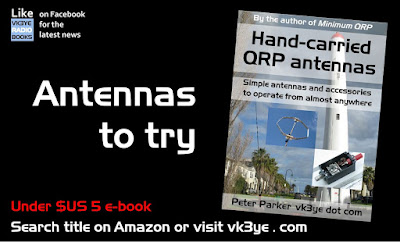Our first real post discussed the coax fed half wavelength dipole. It's a basic antenna building block and it's hard to go wrong with one.
The simplest way around that what is often called a 'multi' or 'fan' dipole. You keep the one feedline and balun (if used) but have multiple wires running off the centre. Like a paper fan. The wires are cut for the bands that you want. Effectively parallel dipoles.
So if you had a 40 metre band 7 MHz dipole (20 metres end to end) and wanted to add 20 metres (14 MHz) then you add two shorter wires each about 5 metres long. That's simple and foolproof. Although you may need to slightly trim the length of the wires due to interaction between them. Interaction is why you don't want them too close to one another.
Adding more wires gives more bands. But beyond three or four of them it gets a bit messy - like looking through a spiders web. And you can get more interaction, making trimming harder. So I suggest starting simple, cutting the shorter ones first to size.
Enjoy the following articles and videos on fan dipoles.
* M0MCX 40/30/20m fan dipole
* Multiband fan dipole by N4UJW
* Modeling a fan dipole for DX by W1DYJ
* How to build a fan dipole for Field Day (DX Commander's video)
If you haven't built a dipole before, I suggest starting with one band only. My article here.
A dipole's main limitation is that it's (largely) only a single band affair. That can be a problem at home with our transceivers covering numerous bands but our partners wanting few antennas.
The simplest way around that what is often called a 'multi' or 'fan' dipole. You keep the one feedline and balun (if used) but have multiple wires running off the centre. Like a paper fan. The wires are cut for the bands that you want. Effectively parallel dipoles.
So if you had a 40 metre band 7 MHz dipole (20 metres end to end) and wanted to add 20 metres (14 MHz) then you add two shorter wires each about 5 metres long. That's simple and foolproof. Although you may need to slightly trim the length of the wires due to interaction between them. Interaction is why you don't want them too close to one another.
Adding more wires gives more bands. But beyond three or four of them it gets a bit messy - like looking through a spiders web. And you can get more interaction, making trimming harder. So I suggest starting simple, cutting the shorter ones first to size.
Enjoy the following articles and videos on fan dipoles.
* M0MCX 40/30/20m fan dipole
* Multiband fan dipole by N4UJW
* Modeling a fan dipole for DX by W1DYJ
* How to build a fan dipole for Field Day (DX Commander's video)
If you haven't built a dipole before, I suggest starting with one band only. My article here.
PS: Want to read more about antennas? Consider this selection of antenna books. They are affiliate links meaning that I receive a small commission (at no extra cost to you) if you decide to purchase.




















